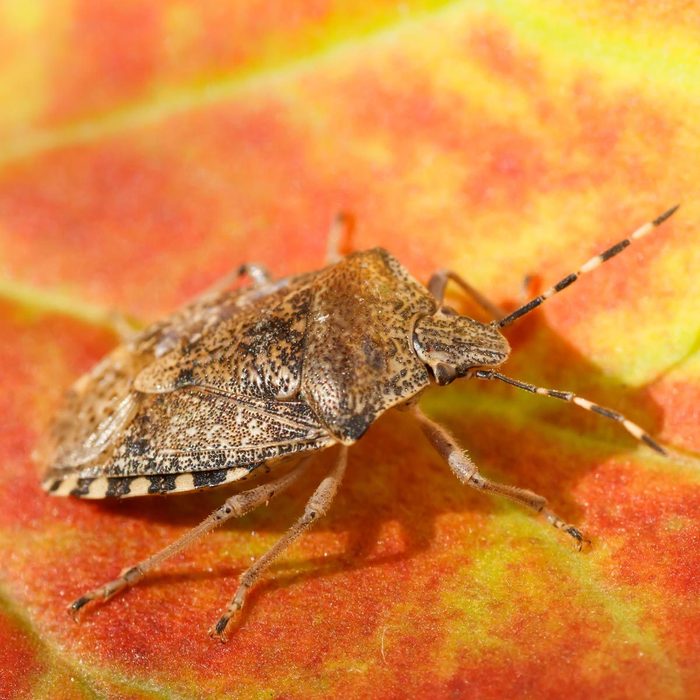How to Get Rid of Stink Bugs in Your Garden
Updated: Nov. 07, 2022

Stink bugs not only stink but are also tough to kill in your garden and your house. We talked to the experts for answers.
Our editors and experts handpick every product we feature. We may earn a commission from your purchases.
If you spend any time near gardens or vegetable and fruit crops, you’ve probably laid eyes on a few brown marmorated stink bugs. Some people refer to these as shield bugs, but either moniker identifies the same pest. (The scientific name for the stink bugs is halyomorpha halys, in case you were wondering.)
More concerning than their name, though, is their game. These not-so-innocent looking insects have one goal in life — to take control of just about any crop they can get their tiny little legs on. This includes everything from commercial tomato crops to the peppers and green beans you carefully cultivated in your backyard.
Here’s how to get rid of grasshoppers in your yard.
What Are Shield Bugs and Where Do They Come From?
Shield/stink bugs are an invasive species that arrived in the U.S. in the 1990s from Asia via Allentown, Pennsylvania, says David Price, a certified entomologist and technical director for Mosquito Joe, a nationwide pest control company. According to the Environmental Protection Agency (EPA), they likely hitched a ride in a shipping container. From there, the pests spread rapidly around the nation.
Now, shield bugs are almost everywhere — in 47 states to be exact. They are the biggest nuisance in Oregon, Michigan, Tennessee and the mid-Atlantic region, where they are often found chowing down on agricultural crops. Favorites include apples, pears, grapes, peppers, tomatoes, hazelnuts and corn.
“They actually attack agricultural crops pretty aggressively,” Price says. How aggressively? In 2010, tree fruit producers lost more $37 million in crops to stink bugs, per a report from the University of Florida.
If you see spotted lanternflies in your yard, here’s what you should do.
How Do I Identify a Brown Marmorated Shield Bug?
Shield/stink bugs are brown, with white bands on their antennas and legs. They also have alternating light and dark bands on their abdomen. As for the exoskeleton, it resembles — you guessed it — a shield.
If you see a green bug with a similar shape, yes, that is a shield bug, too. However, the green version is native to North America and therefore not as much of a nuisance to crops, says Heather Stoven, an entomologist with Oregon State University. They still stink, though.
Got holes in your leafy greens? You have cabbage worms.
Why Are Shield Bugs Also Called Stink Bugs?
And speaking of the stink, what is the story behind their nickname?
“When you crush them, they have a really foul odor,” says Price. The odor, he says, exists to fend off would-be predators. It works, too; the bug has no known predators. The odor is not harmful, Price says, just unpleasant.
Discover 7 natural ways to keep bees and wasps away from hummingbird feeders.
How Do I Know I Have a Stink Bug Problem?
Like many insects, stink bugs lay their eggs on the underside of leaves. Once the eggs hatch, the nymphs (i.e. baby insects) start feeding on those leaves, eventually joining their adult relatives on the fruits and vegetables themselves. You’ll know they’ve been around because you’ll see unsightly brown spots on the skins of your crops.
Unfortunately, they don’t disappear in winter, either. Instead, Price says, they seek shelter and warmth in and around your home.
Potential stink bug hibernation sites include overgrowth and weeds around the yard, wood piles, or any little crack or hole on a structure (house, shed, etc.) they can squeeze into. They’ll hang out all winter long. When spring arrives, they’ll move out of hiding and head on over to your garden.
Find out how to control a Japanese beetle infestation.
How Do I Get Rid of Stink Bugs?
We wish we had better news, but it isn’t easy to get the brown marmorated stink bug out of your garden. They are extremely prolific with no known predators (though its cousin, the green stink bug, has many predators). Price says pesticides have little effect on them thanks to their tough-as-nails exoskeleton.
The best you can do is to control them, and consider yourself lucky if sightings in your garden are few and far between. Here are a few tips to keep them at bay, per Price and Stoven:
- Make sure all the cracks around your doors, windows, siding and pipes are well-sealed before winter. And don’t leave piles of yard debris sitting around. This will discourage overwintering.
- If you see them crawling around your house after a long winter’s nap, vacuum them up.
- When spring arrives, hang pheromone traps around your garden so you can catch them in the act.
- Check leaves for eggs. If you see them, remove or cut the leaves off.
- Spray plants with a kaolin clay solution. Kaolin is a mineral that is known to repel insects. It isn’t a sure thing, but it’s worth a try.
- Place row covers over your crops.



















